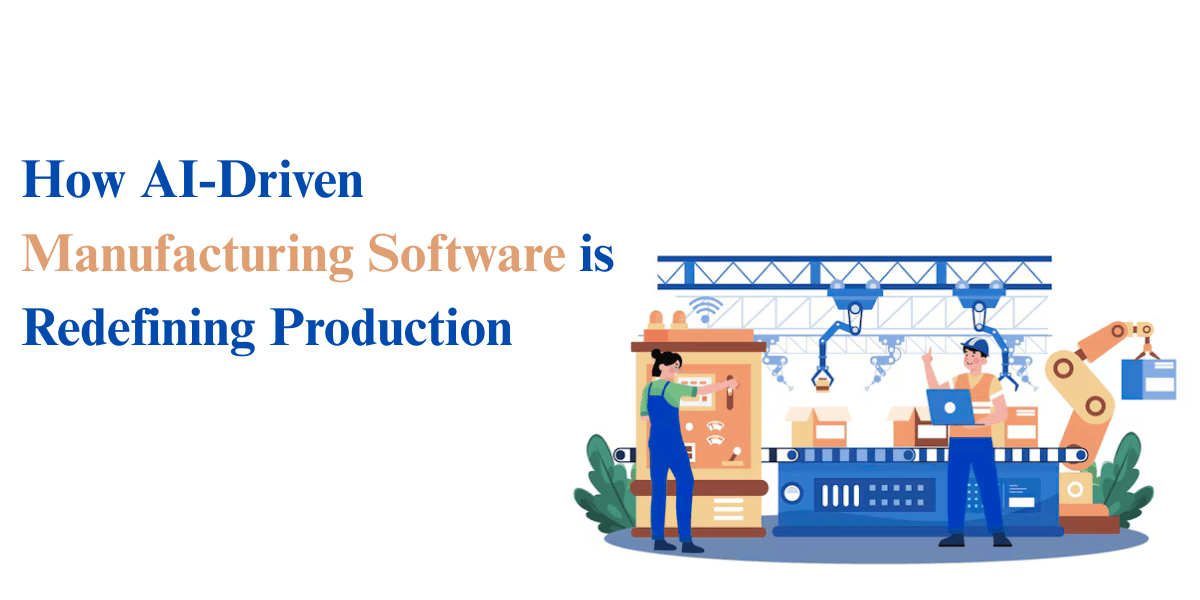Introduction
The manufacturing industry is in the midst of a digital revolution. Gone are the days when traditional machinery and human labor alone powered the industrial landscape. Today, the fusion of data, automation, and artificial intelligence (AI) is giving rise to what is now known as smart manufacturing. This shift is being accelerated by AI-driven manufacturing software that brings unparalleled precision, efficiency, and adaptability to production environments.
As manufacturers strive to stay competitive in global markets, integrating cutting-edge technology becomes not just an advantage but a necessity. AI in manufacturing is enabling real-time decision-making, predictive maintenance, and operational agility—paving the way for a new era of intelligent production systems. These innovations are not only reducing costs but also enhancing product quality, minimizing waste, and improving the overall responsiveness of supply chains.
This blog explores the transformative role of AI-driven manufacturing software, highlighting its core components, use cases, and long-term value. From predictive maintenance to the future of manufacturing software development, we’ll explore how AI is redefining modern production and why it’s critical for industry leaders to embrace this change.
What is Smart Manufacturing?
Smart manufacturing is the integration of digital technologies such as AI, IoT, big data, and robotics into traditional manufacturing processes to create highly responsive, adaptive, and efficient production environments. It represents the next stage in the industrial evolution—also referred to as Industry 4.0—where automation, connectivity, and intelligence converge to deliver unprecedented levels of control and productivity.
At the core of smart manufacturing is data—collected from machines, sensors, and production lines in real-time. This data is analyzed using AI algorithms to uncover insights that drive better decision-making. Unlike conventional systems, which rely on reactive measures, smart manufacturing is predictive, self-optimizing, and capable of autonomous adjustments.
The importance of smart manufacturing lies in its ability to meet dynamic customer demands while maintaining operational efficiency. With real-time monitoring and AI-driven analytics, manufacturers can identify bottlenecks, reduce unplanned downtime, and proactively manage quality issues. It’s a holistic approach that blends the physical and digital realms, ensuring greater flexibility and sustainability in production.
By incorporating AI in manufacturing, companies are building agile systems that can scale with demand, adapt to market changes, and continuously improve without massive manual intervention.
Key Features & Functionalities
AI-driven manufacturing software brings a powerful set of tools and features that drastically improve how production environments function. These core functionalities form the backbone of smart manufacturing and enable manufacturers to remain competitive and agile in today’s fast-paced landscape.
1. Real-Time Data Analytics: Real-time analytics is the foundation of smart manufacturing. With sensors and IoT devices embedded across the production floor, massive amounts of data are continuously collected and processed. AI algorithms analyze this data on the fly, identifying inefficiencies, quality deviations, and maintenance needs. This enables rapid, informed decisions that optimize production and minimize waste.
2. Machine Learning Integration: Machine learning models embedded in manufacturing software allow systems to learn from historical data and predict future outcomes. Whether it’s forecasting equipment failure or optimizing production schedules, these algorithms refine their predictions over time, becoming more accurate and impactful. This capability helps streamline processes and anticipate problems before they occur.
3. Workflow Automation: Workflow automation through AI reduces manual intervention by executing routine tasks, triggering alerts, and synchronizing operations across systems. From material handling to assembly line coordination, automation ensures seamless communication between different units, boosting overall productivity and consistency.
4. Predictive Algorithms: Predictive algorithms are crucial in forecasting equipment failures, demand fluctuations, and supply chain disruptions. By analyzing patterns in historical and real-time data, these algorithms provide actionable insights that allow manufacturers to prepare and respond proactively, rather than reactively.
These features are not just technical upgrades—they’re strategic enablers for future-ready manufacturing.
Predictive Maintenance: A Game-Changer
Among the most transformative applications of AI in manufacturing is predictive maintenance software. Unlike reactive maintenance (fixing equipment after failure) or preventive maintenance (scheduled servicing), predictive maintenance leverages AI to predict when a machine is likely to fail, based on real-time data and usage patterns.
This approach drastically reduces unplanned downtime, which can cost manufacturers millions annually. Sensors attached to machinery collect operational data such as vibration, temperature, and power usage. AI-driven manufacturing software analyzes this data to detect anomalies or early warning signs of equipment failure.
What sets predictive maintenance apart is its precision and efficiency. It eliminates unnecessary maintenance checks and focuses resources only when and where they’re needed. The benefits are manifold: longer equipment lifespan, reduced repair costs, minimized production disruptions, and improved safety.
Additionally, predictive maintenance software can be integrated with ERP and inventory systems, ensuring that parts are available just in time and service schedules are automatically aligned. This not only optimizes maintenance workflows but also contributes to more efficient asset management.
Benefits of Adopting Smart Manufacturing Technologies
The transition to smart manufacturing is not just a technological upgrade—it’s a strategic move that delivers measurable advantages across every area of production. As manufacturers face rising costs, labor shortages, and increasing market demand, the benefits of adopting AI-driven manufacturing software and other Industry 4.0 technologies are becoming more apparent and essential.
Increased Efficiency & Reduced Downtime
One of the most immediate and tangible benefits of smart manufacturing is the significant boost in operational efficiency. Through the use of real-time data analytics and machine learning, manufacturers can continuously monitor production systems and proactively address bottlenecks. Predictive maintenance software plays a critical role here—by analyzing equipment performance data, it predicts failures before they happen, thus minimizing unplanned downtime. This leads to streamlined operations, fewer interruptions, and optimal use of resources, ultimately reducing production costs and increasing output.
Better Decision-Making through AI Insights
AI in manufacturing is transforming decision-making by delivering actionable insights based on large volumes of data. AI-driven manufacturing software collects and processes information from every aspect of production, offering real-time reports and future projections. This allows plant managers and executives to make faster, data-backed decisions—whether it’s adjusting production schedules, reallocating labor, or optimizing machine workloads. With machine learning models identifying patterns and anomalies, leaders are equipped to respond to issues before they escalate.
Energy Savings & Sustainability
Smart manufacturing also contributes to energy efficiency and environmental sustainability. AI algorithms can monitor energy consumption at a granular level and automatically adjust machine usage to minimize waste. By reducing idle time, optimizing heating or cooling systems, and ensuring only necessary machines are running, manufacturers can significantly cut energy costs. In addition, reduced waste and resource optimization contribute to corporate sustainability goals, helping companies comply with environmental regulations and appeal to eco-conscious stakeholders.
Improved Supply Chain Transparency
Today’s supply chains are complex and globally interconnected. Smart manufacturing technologies enhance transparency by integrating production systems with supply chain management software. This provides real-time visibility into inventory levels, supplier performance, logistics status, and customer demand. With AI-driven tools, manufacturers can forecast demand more accurately, respond faster to disruptions, and make smarter procurement decisions. The result is a more agile, responsive, and resilient supply chain that reduces delays, avoids overproduction, and improves customer satisfaction.
Together, these benefits position smart manufacturing as a must-have for companies seeking to scale efficiently, remain competitive, and future-proof their operations.
Future of Manufacturing Software Development
Manufacturing Software Development is rapidly transitioning into a more agile, scalable, and intelligent era. As the industry embraces digital transformation, the demand for software that can adapt quickly to changing requirements, integrate seamlessly with smart devices, and offer real-time decision-making capabilities is soaring. Traditional monolithic applications are being replaced by modular, AI-powered solutions designed to support dynamic, data-driven manufacturing environments.
One of the most significant shifts is the rise of low-code and no-code platforms. These tools allow non-developers, such as process engineers or plant managers, to create or customize applications with minimal programming knowledge. This democratization of software development accelerates innovation and reduces dependency on IT departments. Manufacturers can quickly build dashboards, automate workflows, or integrate new machine sensors without waiting months for a traditional development cycle.
Edge AI is also revolutionizing manufacturing software by enabling real-time data processing directly at the source, on machines and devices rather than in the cloud. This reduces latency and allows for immediate responses to critical events like equipment failures or quality deviations. Edge AI is particularly valuable in environments where every second counts and internet connectivity may be limited or unreliable.
Another powerful innovation is the use of digital twins—virtual replicas of physical assets or entire production systems. Digital twins simulate real-world performance, helping manufacturers test process changes, forecast maintenance needs, and identify inefficiencies without disrupting actual operations. They offer a safe, scalable way to experiment and optimize production strategies.
Despite these advances, there’s a growing talent gap in AI software development specific to manufacturing. The industry requires developers and engineers who understand both complex manufacturing workflows and advanced AI/ML technologies. Unfortunately, this cross-disciplinary expertise is in short supply. Companies must either upskill existing staff or partner with niche development firms to bridge the gap and keep pace with innovation.
Conclusion
Smart manufacturing is no longer a futuristic concept—it’s today’s competitive advantage. By integrating AI-driven manufacturing software, companies can transform how they operate, maintain, and scale production. From real-time analytics and machine learning to predictive maintenance and workflow automation, these technologies empower manufacturers to innovate confidently.
Predictive maintenance, in particular, stands out as a critical enabler of efficiency and cost reduction. Compared to reactive and preventive approaches, it offers a smarter, more sustainable solution for managing equipment health and minimizing downtime.
The benefits extend beyond operations. AI insights improve strategic decision-making, enhance energy efficiency, and provide greater supply chain visibility. As a result, manufacturers improve output and achieve long-term sustainability and resilience.
Looking ahead, the future of Manufacturing Software Development promises even more innovation. With the rise of low-code tools, edge computing, and digital twins, manufacturers will be able to build, test, and deploy solutions faster than ever. However, success will depend on bridging the skills gap and fostering a culture of continuous innovation.
For manufacturing leaders, now is the time to act. Start small—launch pilot programs that demonstrate quick wins and scale based on proven results. Smart manufacturing is a journey, and the sooner you begin, the sooner you’ll reap the rewards.






Leave a Reply